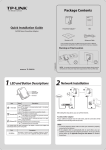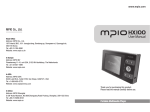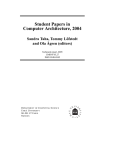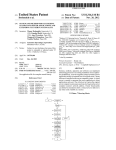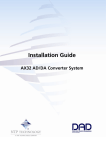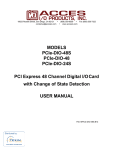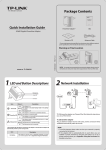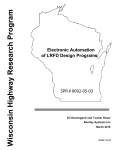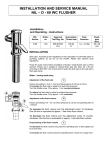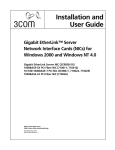Download Method and apparatus to retrieve information in a network
Transcript
US007899911B2 (12) Ulllted States Patent (10) Patent N0.: Jensen et al. (54) (75) (45) Date of Patent: Mar. 1, 2011 METHOD AND APPARATUS TO RETRIEVE 6,553,420 B1 * 4/2003 Karger et al. ............... .. 709/226 INFORMATION INANETWORK 6,701,415 B1 * 3/2004 Hendren, III . 6,792,461 B1* 9/2004 6,792,463 B1 * 6,839,881 B2 * 9/2004 Lambenon et a1~ ~~~~~~~~~ ~~ 709/227 .. 715/513 1/2005 Myers et al. .... .. 709/246 Inventors: Kell Michael Jensen, Gentofte (DK); Alex Agerholma Glostrup (DK) . _ . _ (*) US 7,899,911 B2 Not1ce: _ _ _ 6,871,236 B2* 3/2005 2001/0056476 A1* 12/2001 _ FOREIGN * Subject to any d1scla1mer, the term of th1s patent is extended or adjusted under 35 CN WO .. 711/138 Hericourt .................... .. 709/225 Fishmanetal. .. Benayoun et al. .. 709/218 PATENT Heller DOCUMENTS ‘ ‘ ‘ ‘ ‘ ‘ ‘ ‘ ‘ ‘ ‘ ‘ ‘ ‘ ‘ ‘ ‘ ‘ ‘ ‘ ‘ ‘ ‘ ‘ ‘ “ 1294712 A 98/43177 A1 50001 10/1998 U.S.C. 154(1)) by 1929 days. OTHER PUBLICATIONS (21) App1.No.: 09/877,928 (22) Filed; (65) (52) (58) devel oper.netscape .corn/ doc s/manual s/proxy. html, Introduction, Table of Contents, Chapters 5 and 9, pp. 1-52 as printed.* Prior Publication Data US 2002/0188698 A1 (51) Netscape Communications Corporation, Netscape Proxy Server Administrator’s Guide, Version 3.5 for Unix, Mar. 1998, from http:// Jun_ 7, 2001 Int‘ Cl‘ G06F 15/16 Angel, “Lesson 129: Proxy Servers,”Apr. 1999, Network Magazine, Dec. 12, 2002 vol. 14, Iss. 4, pp. 27ff.* WinRoute Pro 3.0 User’s Manual; Tiny Software Inc.; 1999* Rubas; WinProxy 1.4 User’s Manual; 1997.* C2NET Software, Inc., “Stronghold Web Server 2.4.1 Adminstration (200601) U.S. Cl. ....................................... .. 709/227; 709/219 Field Of Classi?cation Search ................ .. 709/ 202, Guide,” >On1inei; Sep, 1998 Xp002214714, 37 pages, Intel Corp., “Persistence MechanismsiEnabling today’s dynamic 709/226, 219, 227, 228, 203 See application ?le for complete search history. e-Business transactions,”White paper, ’Online! 2000 XP002214713, 8 Page$~ (56) Alteon Websystems; “Virtual Matrix Architecture: Scaling Web Ser vices for Performance and Capacity,” White paper, ’Online! Apr. 2000, XP002191242, 13 pages. References Cited U.S. PATENT DOCUMENTS 5,802,292 A * 9/1998 * cited by examiner Mogul ........................ .. 709/203 5,852,717 A * 12/1998 Bhide et al. .. 709/203 5,991,306 A * 11/1999 Bums et a1‘ """"""""" " 370/429 6,003,082 A * 12/1999 Primary ExamineriAaron Strange (74) Attorney, Agent, or Firm * Kacvinsky Daisak PLLC Gampper et al. ........... .. 709/225 6,085,193 A * 7/2000 Malkin et al. 6,167,438 A * 12/2000 Yates et al. 707/10 .. 709/216 (57) .. 709/247 An improved method and apparatus to retrieve information 6,247,050 6,185,625 B1* 6/2001 2/2001 Tso etal. . 6,421,733 B1* 7/2002 Tso et al. 6,438,652 B1 * 8/2002 Jordan et al. ................ .. 711/120 709/224 . .. ABSTRACT over a network is described. 709/246 18 Claims, 4 Drawing sheets ggg receive a first request for mfnrmation 302 over a first connection retrieve the information over a second i—304 connection I detect that the first connection is — 306 terminated i receive a second e uest [or the information over a d connection J03 determine whether the second request matches the first request J10 sending the information over the third __312 connection in accordance with the determination @ US. Patent Mar. 1, 2011 Sheet 1 014 US 7,899,911 B2 62m @3250 F E026 0 -, E96 US. Patent Mar. 1, 2011 Sheet 2 014 US 7,899,911 B2 224 ZOT ZOT 204 QOT HO Operator Processor Adapter interface “08 21? MT 212 _. Program Partition 214____ Data Paritiuns Data Files 216____ Operating System __220 Program Fiies —222 FIGQ US. Patent Mar. 1, 2011 Sheet 3 014 US 7,899,911 B2 3 0 \ Start receive a first request for information $302 over a first connection retrieve the information over a second -3O4 connection detect that the first connection is terminated ————SO6 receive a second request for the ———3O8 information over a third connection determine whether the second request " 310 matches the first request sending the information over the third ‘#312 connection in accordance with the determination End Pie 3 US. Patent Mar. 1, 2011 Cmm Sheet 4 of4 WIOSWHCR US 7,899,911 B2 Server SYN SYhLAC CK ‘UNI K Eqzmuduwod 1010 CK Ec?hudu 603M007 CK E$P1 (11nd. CK Y YN (11 AOK EQwnadu Zinndudmd CK SPqbody ACK um. mm 1!!!" US 7,899,911 B2 1 2 METHOD AND APPARATUS TO RETRIEVE INFORMATION IN A NETWORK server may be connected to an access device, such as a load balancer, web switch, virtual private network gateway, and so forth. The access device may manage how information is stored and retrieved from the server. For example, a load balancer may operate to make multiple servers appear like a BACKGROUND single, high-powered network resource to those accessing the array of servers. It does this by selectively forwarding con nections to the many servers arrayed behind it in an equitable manner, according to such factors as the server’s operational health, nature of the query and so forth. The load balancer may check the operational health of a server by testing the A network typically comprises a plurality of network nodes connected together by a communications medium. A network node may comprise, for example, a switch, router, personal computer, server, network appliance or any other network device. A network node, such as a server, may store information in the form of ?les created in accordance with server with an arti?cial client, or by sending it a series of scripts that can try out critical pages and look at the responses, various formats, such as a hypertext markup language (HTML) ?le, extensible markup language (XML) ?le, and so forth. A ?le may also be referred to as a “page” or “web page.” Whenever a user may desire a particular ?le, the user may request access to the ?le using a number of network protocols. for example. A protocol may be a predetermined process by which infor mation is exchanged between network nodes. Due to the high performance demands of certain applica tions, it may become necessary to implement technology to personal computer (PC). The information may comprise, for A user may typically attempt to access information on a server using a browser located on a client computer, such as a ensure that a user may access a desired ?le with a high level example, a web page. The user may initiate the action by typing in an information identi?er for the web page. An example of an information identi?er may be a uniform resource locator (URL). The browser may then use the URL of con?dence and reduced latency. To accomplish this, the to attempt to establish a connection between the client com same ?le may be stored on a number of different servers. puter and the server where the web page is stored using a 20 Whenever a user sends a request to access a ?le stored on a server, the request may be intercepted by a network access 25 Version 1 .1 as de?ned by the Internet Engineering Task Force device, such as a “load balancer” or “web switch.” The net work access device may operate to coordinate and control (IETF) Draft Standard Request For Comment (RFC) 2616, June 1999, and available from “www.ietf.org” (“HTTP Speci?cation”), although the embodiments of the invention how information is stored and accessed in order to optimiZe overall network performance. Optimized performance might be realiZed, for example, in lower access times for informa conventional network protocol. An example of such a proto col may include the Hypertext Transfer Protocol (HTTP) 30 tion stored on the servers. Due to the increasing demands for lower access times, it can be appreciated that there is a sub are not limited in this context. The network access device such as a load balancer may intercept and process the connection request on behalf of the stantial need for technologies that may retrieve information server. If the requested web page resides on more than one faster from a server over a network. server in the network, the load balancer may select a particu 35 lar server based on various parameters, such as those dis cussed above. The load balancer may then attempt to establish BRIEF DESCRIPTION OF THE DRAWINGS a connection with the selected server. Once a connection is 40 established with the appropriate server, the server may send the requested web page to the load balancer. The load bal ancer may then send the web page to the client computer, where the browser may display the web page for the user. A problem may occur if there is an unreasonable delay in 45 accessing the web page. The user may get impatient and cancel the request, only to submit another request for the same web page immediately thereafter. The cancellation may result in the termination of the connection between the client computer and the load balancer, and also the connection The subject matter regarded as embodiments of the inven tion is particularly pointed out and distinctly claimed in the concluding portion of the speci?cation. Embodiments of the invention, however, both as to organiZation and method of operation, together with objects, features, and advantages thereof, may best be understood by reference to the following detailed description when read with the accompanying draw ings in which: FIG. 1 is a system suitable for practicing one embodiment of the invention. FIG. 2 is a block diagram of an access device in accordance with one embodiment of the invention. FIG. 3 is a block ?ow diagram of the programming logic performed by an information management component in between the load balancer and the server. Once the user sub mits the other request, both connections will have to be re 50 To avoid this and other potential problems, one embodi accordance with one embodiment of the invention. FIG. 4 illustrates a message ?ow in accordance with one ment of the user maintains the connection between the load balancer and the server despite the cancellation of the con embodiment of the invention. 55 nection between the client computer and the load balancer. Once the load balancer receives the requested information, the load balancer may store the requested information with the source address of the client computer and the information address of the information (e. g., the URL) in an information 60 table. If the client computer attempts to establish a new con DETAILED DESCRIPTION In the following detailed description, numerous speci?c details are set forth in order to provide a thorough understand ing of the embodiments of the invention. It will be understood by those skilled in the art, however, that the embodiments of the invention may be practiced without these speci?c details. In other instances, well-known methods, procedures, compo nection requesting the same information, the load balancer may retrieve the information from the information table and send it to the client computer without having to open a new nents and circuits have not been described in detail so as not to obscure the embodiments of the invention. One embodiment of the invention may increase the speed by which information may be retrieved from a server. The established prior to retrieving the requested information. This may lead to the inef?cient use of network resources. connection to the server. 65 This embodiment of the invention provides several advan tages. For example, this embodiment of the invention avoids the latency associated with re-establishing a connection US 7,899,911 B2 3 4 between the load balancer and the server. The load balancer used herein, the phrase “adapted to be executed by a proces may also avoid having to go through the selection process to sor” is meant to encompass instructions stored in a com select a particular server from the group or cluster of servers. pressed and/or encrypted format, as well as instructions that have to be compiled or installed by an installer before being executed by the processor. Further, client 200 may contain various combinations of machine-readable storage devices through various I/ O controllers, which are accessible by pro In addition, the server would not have to retrieve the infor mation twice, thereby releasing resources for other uses. It is worthy to note that any reference in the speci?cation to “one embodiment” or “an embodiment” means that a particu lar feature, structure, or characteristic described in connec tion with the embodiment is included in at least one embodi cessor 202 and which are capable of storing a combination of computer program instructions and data. Memory 210 is accessible by processor 202 over bus 208 and includes an operating system 216, a program partition ment of the invention. The appearances of the phrase “in one embodiment” in various places in the speci?cation are not necessarily all referring to the same embodiment. Referring now in detail to the drawings wherein like parts 212 and a data partition 214. In one embodiment of the invention, operating system 216 may comprise an operating are designated by like reference numerals throughout, there is system sold by Microsoft Corporation, such as Microsoft Windows® 95, 98, 2000 and NT, for example. Program par illustrated in FIG. 1 a system suitable for practicing one embodiment of the invention. FIG. 1 is a block diagram of a network 100. Network 100 may comprise a client computer tition 212 stores and allows execution by processor 202 of program instructions that implement the functions of each respective system described herein. Data partition 214 is accessible by processor 202 and stores data used during the 102, a network 104, an access device 106 and a server 108. In one embodiment of the invention, server 108 may be part of an array of servers connected together by a network, for 20 example. FIG. 2 is a block diagram of a system in accordance with one embodiment of the invention. FIG. 2 illustrates a system 200 that may be representative of an access device, such as access device 106. As shown in FIG. 2, system 200 may execution of program instructions. In one embodiment of the invention, program partition 212 contains program instructions that may be collectively referred to herein as an information management component. Although this embodiment of the invention uses one compo 25 comprise a processor 202, an input/output (I/ O) adapter 204, nent, it can be appreciated that the functionality performed by this component may be combined with other components, or an operator interface 206, a memory 210 and a disk storage separated into additional components, and still fall within the 218. Memory 210 may store computer program instructions and data. The term “program instructions” may include com scope of the invention. I/O adapter 204 may comprise a network adapter or net puter code segments comprising words, values and symbols from a prede?ned computer language that, when placed in 30 suitable technique for controlling communication signals between computer or network devices using a desired set of combination according to a prede?ned manner or syntax, cause a processor to perform a certain function. Examples of communications protocols, services and operating proce a computer language may include C, C++ and assembly. Processor 202 executes the program instructions, and pro cesses the data, stored in memory 210. Disk storage 218 stores data to be transferred to and from memory 210. I/O adapter 204 communicates with other devices and transfers data in and out of the computer system over connection 224. Examples of other devices may include a microphone and 35 are not limited to this context. I/ O adapter 204 also includes appropriate connectors for connecting I/O adapter 204 with a suitable communications medium. I/O adapter 204 may operator by accepting commands and providing status infor receive communication signals over any suitable medium 45 ments. Processor 202 can be any type of processor capable of providing the speed and functionality required by the embodiments of the invention. For example, processor 202 could be a processor from family of processors made by Intel such as copper leads, twisted-pair wire, co-axial cable, ?ber optics, radio frequencies, and so forth. The operations of systems 100 and 200 may be further described with reference to FIG. 3 and its accompanying examples. Although FIG. 3 as presented herein may include a particular processing logic, it can be appreciated that the processing logic merely provides an example of how the general functionality described herein can be implemented. Further, each operation within a given processing logic does Corporation, Motorola Incorporated, Sun Microsystems Incorporated, Compaq Computer Corporation and others. Processor 202 may also comprise a digital signal processor (DSP) and accompanying architecture, such as a DSP from Texas Instruments Incorporated. dures, for example. In one embodiment of the invention, I/O adapter 204 may operate, for example, in accordance with the Transmission Control Protocol (TCP) as de?ned by the IETF standard 7, RFC 793, adopted in September, 1981, and the Internet Protocol (IP) as de?ned by the IETF standard 5, RFC 791, adopted in September, 1981, both available from “www.ietf.org”, although the embodiments of the invention display, such as microphone 106 and display 102, respec tively. Operator interface 206 may interface with a system mation. All these elements are interconnected by bus 208, which allows data to be intercommunicated between the ele work interface card (NIC) con?gured to operate with any 55 In one embodiment of the invention, memory 210 and disk storage 218 may comprise a machine-readable medium and not necessarily have to be executed in the order presented unless otherwise indicated. FIG. 3 is a block ?ow diagram of the programming logic performed by an information management component in may include any medium capable of storing instructions adapted to be executed by a processor. Some examples of accordance with one embodiment of the invention. As shown in FIG. 3, a ?rst request for information is received over a ?rst such media include, but are not limited to, read-only memory connection at block 302. The ?rst request for information may be, for example, a request for a web page using an HTTP “Get” command in accordance with the HTTP Speci?cation. The ?rst connection may be, for example, a connection (ROM), random-access memory (RAM), programmable ROM, erasable programmable ROM, electronically erasable programmable ROM, dynamic RAM, magnetic disk (e.g., ?oppy disk and hard drive), optical disk (e.g., CD-ROM) and any other media that may store digital information. In one embodiment of the invention, the instructions are stored on the medium in a compressed and/or encrypted format. As 65 between a client computer and an access device, such as access device 106. The information may be retrieved over a second connection at block 304. The second connection may be, for example, a connection between an access device and a US 7,899,911 B2 5 6 server containing the requested information, such as server 108. The access device may detect that the ?rst connection has been terminated at block 3 06. The ?rst connection may be terminated for various reasons, such as intentionally by the ever, keeps the TCP connection toWard the server open to receive the requested information. In segment 4, a neW TCP session is set up betWeen the client computer and the Web sWitch. The client computer sends a request for a URL. Since the TCP connectionbetWeen the Web sWitch and the server remains open, a neW TCP user via a cancellation or refresh request sent from a browser at the client computer, a break in the physical or logical connection betWeen the client computer and access device, connection betWeen the Web sWitch and the server is not opened. and so forth. The access device may receive a second request for the information over a third connection at block 308. The third connection may comprise, for example, a neW connec tion betWeen the client computer and the access device to replace the terminated ?rst connection. The access device may determine Whether the second request matches the ?rst request at block 310. The access device may send the infor mation over the third connection at block 312 in accordance With the determination at block 310. After retrieving the information at block 304, the access device may store the information in memory, such as memory 210 or disk storage 218. In one embodiment of the invention, the ?rst request may comprise a ?rst source address and a ?rst information address. The access device may store the ?rst source address, the ?rst information address and the informa In segment 5, the Web sWitch checks its information table to determine Whether there is an outstanding URL request toWard the server for the source IP address already. If so, the previous URL request is spliced With the neW URL request. As a result, the Web sWitch may avoid selecting a server, opening a neW connection, and sending the neW URL request to the selected server. In segment 6, the Web sWitch may receive the Web page associated With the previous URL request. The Web sWitch may perform a validation process to ensure that the received Web page is the same as the one requested in the neW URL 20 computer. If the Web page is not valid, a neW server may be selected, a connection opened With the server, and a neW URL request sent to the selected server. tion in an information table. The access device may receive a second request at block 308. The second request may com prise a second source address and a second information address. The access device may search the information table to determine Whether the second source address matches the ?rst source address, and the ?rst information address matches the second information address. If both match, the access device may retrieve the information corresponding to the ?rst source address and ?rst information address, and send the information to the client computer over the third connection. In one embodiment of the invention, the source address may comprise an IP address, the information address may comprise a URL, and the information may comprise a Web 25 35 40 information may be deleted if maximum memory usage is reached. 45 third connection, in accordance With the particular protocol In one embodiment of the invention, the servers may not use the source IP address to send the requested information. This may occur, for example, in a netWork using netWork address translation (NAT) technology. In this embodiment of FIG. 4 illustrates a message How in accordance With one embodiment of the invention. As shoWn in FIG. 4, a TCP session is set up betWeen a client computer and an access 50 device, and the access device and a server. The access device may be, for example, a Web sWitch. A Web sWitch may operate the invention, it may not be necessary for the Web sWitch to store the source IP address together With the URL in its information table. While certain features of the embodiments of the invention have been illustrated as described herein, many modi?ca tions, substitutions, changes and equivalents Will noW occur to those skilled in the art. It is, therefore, to be understood that similar to a load balancer. 55 the appended claims are intended to cover all such modi?ca tions and changes as fall Within the true spirit of the embodi ments of the invention. The invention claimed is: 1. A method to retrieve information, comprising: Web sWitch and the server yet. During segment 1, the client computer may send the URL for the desired Web page. Once the access device has received and stored the 60 the requested Web page. The Web sWitch may set up a TCP connection toWard the selected server, and passes the URL request to the server over the opened connection. In segment 3, the TCP connection from the client computer to the Web sWitch is terminated prior to receiving the requested information from the server. The Web sWitch, hoW memory thresholds or keeping invalid information. In one embodiment of the invention, the Web sWitch may use a ?rst-in-?rst-out (FIFO) concept, Where the oldest stored used. requested URL, the Web sWitch may enter segment 2. Seg ment 2 may include, for example, selecting a server having Web sWitch may maintain the information similar to a caching appliance, and delete it after a certain time has passed, for example. In this example, the Web sWitch may associate an aging timer With the source address, URL and information, and may delete certain entries at periodic or predetermined intervals. This may be implemented to avoid exceeding Once the client computer receives the requested informa In segment 1, a TCP session may be set up betWeen the client computer and the Web sWitch. In this example of a message How, there is no TCP connection set up betWeen the Once the Web sWitch has sent the Web page to the client computer, the Web page may delete the Web page and corre sponding entries from its information table. Alternatively, the hoWever, that the source address, information address and tion, the client computer may send a request to terminate the third connection betWeen the client computer and the access device. The access device may then terminate the second connection betWeen the access device and the server, and the In segment 7, the Web sWitch may receive a request to terminate the connection betWeen the client computer and the Web sWitch. Once it receives this request, the Web sWitch may terminate the open connection betWeen the Web sWitch and the server. 30 page, such as an HTML or XML ?le. It can be appreciated, information may be in other formats in accordance With a desired set of protocols, and still fall Within the scope of the invention. request, the Web page is timely, and so forth. If the Web page is valid, the Web sWitch may send the Web page to the client receiving a ?rst request for information from a client at a netWork node over a ?rst connection; establishing a second connection to retrieve said informa tion; detecting that said ?rst connection is terminated prior to 65 retrieval of said information over said second connec tion; retrieving said information over said second connection; US 7,899,911 B2 8 7 10. The method of claim 9, Wherein said second request receiving a second request at the network node for said comprises a second source address and a second information information over a third connection; address, and said sending comprises: determining Whether said second request matches said ?rst request, including Whether said second request is from searching said information table to determine Whether said said client; second source address matches said ?rst source address; determining Whether said ?rst information address matches said second information address; and sending said information in accordance With said determi nation. sending said information over said third connection in accordance With said determination; and deleting said information at the netWork node upon deliv ery of said information to said client. 2. The method of claim 1, Wherein said ?rst request com 11. The method of claim 9, Wherein said source addresses prises a ?rst source address and a ?rst information address, comprise lntemet addresses, and said information addresses further comprising storing said information With said ?rst comprise uniform resource locators. 12. The method of claim 8, Wherein said information com source address and said ?rst information address in an infor mation table prior to receiving said second request. 3. The method of claim 2, Wherein said second request prises a hypertext markup language (HTML) ?le. comprises a second source address and a second information prises an extensible markup language @(ML) ?le. 13. The method of claim 8, Wherein said information com address, and said determining comprises: searching said information table to determine Whether said second source address matches said ?rst source address; and 20 determining Whether said ?rst information address matches said second information address. said storage medium including stored instructions that, 4. The method of claim 3, Wherein said source addresses When executed by a processor, result in receiving a ?rst comprise Internet addresses, and said information addresses comprise uniform resource locators. 5. The method of claim 1, Wherein said information com 25 request for information from a client at a netWork node over a ?rst connection, establishing a second connection to retrieve said information, detecting that said ?rst con nection is terminated prior to retrieval of said informa tion over said second connection, retrieving said infor mation over said second connection, receiving a second prises a hypertext markup language (HTML) ?le. 6. The method of claim 1, Wherein said information com prises an extensible markup language (XML) ?le. 7. The method of claim 1, further comprising: receiving a request to terminate said third connection; and 14. The method of claim 8, further comprising: receiving a request to terminate said third connection; and terminating said second and third connections. 15. An article comprising: a storage medium; 30 request for said information at the netWork node over a third connection, determining Whether said second request matches said ?rst request including Whether said second request is from said client, sending said informa terminating said second and third connections. 8. A method to retrieve information in a netWork, compris ing: tion over said third connection in accordance With said receiving a ?rst request for information from a ?rst net 35 Work node at a second netWork node over a ?rst connec tion; sending said ?rst request over a second connection to a third netWork node; receiving a notice that said ?rst connection is terminated prior to retrieval of said information over said second determination, and deleting said information at the net Work node upon delivery of said information to said client. 16. The article of claim 15, Wherein said ?rst request com prises a ?rst source address and a ?rst information address, 40 connection; and the stored instructions, When executed by a processor, further result in storing said information With said ?rst source address and said ?rst information address in an information table prior to receiving said second request. receiving said information over said second connection at 17. The article of claim 16, Wherein said second request said second netWork node; receiving a second request for said information over a third comprises a second source address and a second information connection at said second netWork node; determining Whether said second request matches said ?rst request, including Whether said second request is from said ?rst netWork node; address, and the stored instructions, When executed by a processor, further result in determining Whether said second sending said information over said third connection to said request matches said ?rst request by searching said informa tion table to determine Whether said second source address 50 ?rst netWork node; and deleting said information at the second netWork node upon delivery of said information to said ?rst netWork node. 9. The method of claim 8, Wherein said ?rst request com prises a ?rst source address and a ?rst information address, further comprising storing said information With said ?rst source address and said ?rst information address in an infor mation table at said second netWork node prior to receiving said second request. 55 matches said ?rst source address, and determining Whether said ?rst information address matches said second informa tion address. 18. The article of claim 15, Wherein the stored instructions, When executed by a processor, further result receiving a request to terminate said third connection, and terminating said second and third connections.









